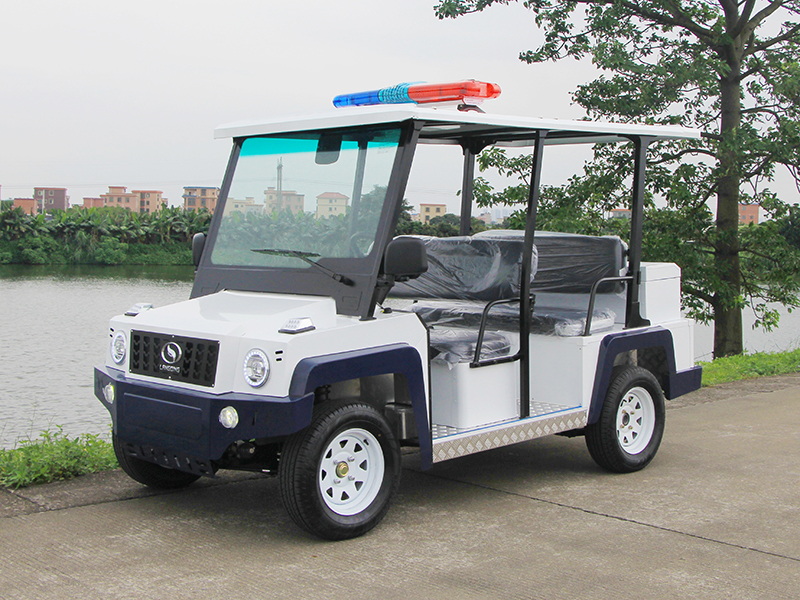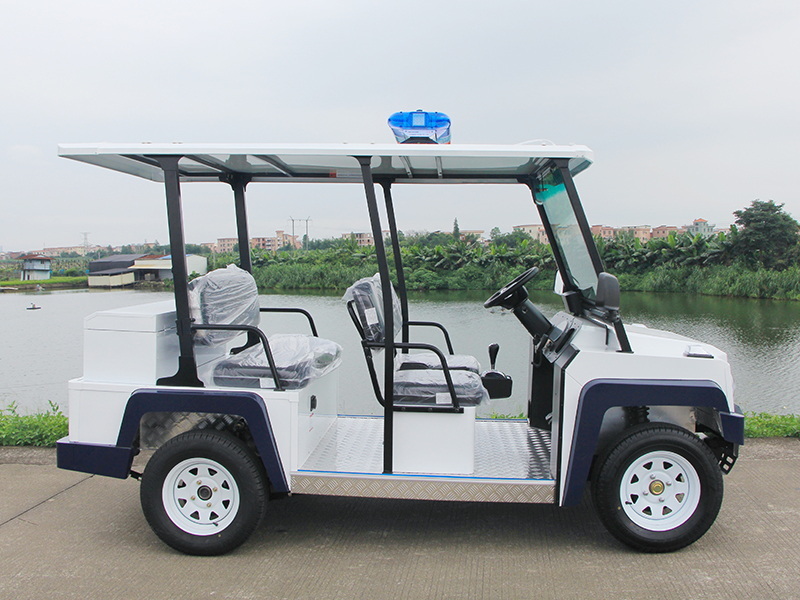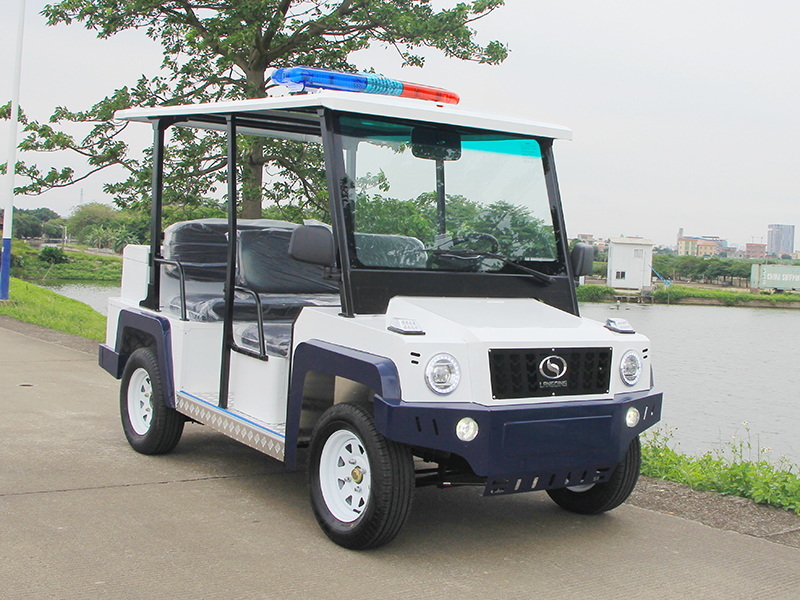Content Menu
● Leading Electric Patrol Car Manufacturer: LangQing Electric
>> About LangQing Electric
● Overview of the Electric Patrol Car Market Size
● Key Drivers of Market Growth
>> Environmental Sustainability and Regulatory Push
>> Cost Efficiency and Operational Savings
>> Technological Advancements
>> Urbanization and Environmental Awareness
● Regional Market Dynamics
>> North America
>> Asia-Pacific
>> Europe and Other Regions
● Market Segmentation
● Notable Electric Patrol Car Models and Innovations
>> LangQing Electric Patrol Carts
>> Kia EV6 Police Car
>> Tesla Model Y and Model 3 Police Fleet
>> Chevy Electric Blazer Police Car
>> Other Innovations
● Challenges Facing the Electric Patrol Car Market
● Future Outlook and Opportunities
● Conclusion
● Frequently Asked Questions (FAQ)
>> 1. What is the current size of the electric patrol car market?
>> 2. What factors are driving the growth of the electric patrol car market?
>> 3. Which regions lead the electric patrol car market?
>> 4. What are the main challenges facing the electric patrol car market?
>> 5. Are there any notable electric patrol car models currently in use?
The electric patrol car market is experiencing rapid growth and innovation, with manufacturers worldwide introducing advanced products to meet the evolving needs of law enforcement, security, and municipal services. In this article, we will provide an in-depth analysis of the current size of the electric patrol car market, its key drivers, regional dynamics, technological advancements, challenges, and future prospects. Special attention will be given to notable manufacturers and products, including those from LangQing Electric, a leading player in this field.

Leading Electric Patrol Car Manufacturer: LangQing Electric
About LangQing Electric
LangQing Electric, based in Guangzhou, China, stands out as a top manufacturer in the electric patrol car market. With over 24 years of experience in car manufacturing, LangQing has developed a robust reputation for quality, innovation, and customer service. The company operates an ISO-certified factory with a strict quality management system and a complete production line capable of handling diverse requirements.
LangQing Electric's product range is extensive and includes:
- Electric Patrol Carts: Designed for law enforcement, campus security, parks, and community patrols.
- Electric Ambulance Carts: For emergency response in large venues and campuses.
- Electric Golf Carts: Suitable for golf courses, resorts, and private communities.
- Electric Mini Trucks: For urban logistics and municipal services.
- Electric Sightseeing Carts: Used in tourist attractions, parks, and campuses.
- Electric Towing Tractors: For industrial and airport applications.
- Customized Vehicles: Tailored to specific customer needs, including branding and functional modifications.
LangQing offers comprehensive OEM and ODM services, enabling partners to develop their own branded electric patrol cars and related vehicles. The company's patented chassis design, high-strength steel frame, and advanced anti-rust treatments ensure long service life and durability. LangQing has successfully served clients in over 50 countries and participated in major international events, underscoring its global reach and reliability.
Overview of the Electric Patrol Car Market Size
As of 2024, the electric patrol car market size is valued at approximately USD 1.5 billion globally. Projections indicate robust growth, with the market expected to reach around USD 5.3 billion by 2033, growing at a compound annual growth rate (CAGR) of about 15.5% to 15.6% between 2026 and 2033.
This growth is fueled by increasing demand for sustainable, energy-efficient law enforcement vehicles, driven by rising fuel costs, environmental concerns, and government incentives promoting green technologies. The market includes various types of electric patrol cars, such as battery electric vehicles (BEVs) and hybrid electric vehicles (HEVs), used by law enforcement agencies and private security firms.
Key Drivers of Market Growth
Environmental Sustainability and Regulatory Push
Governments worldwide are setting ambitious targets to reduce greenhouse gas emissions, and law enforcement agencies are aligning with these goals by adopting electric patrol cars. For example, the U.S. aims for 50% of new vehicle sales to be electric by 2030, encouraging police departments to transition to EVs. Similarly, European and Asian governments are introducing zero-emission mandates for public fleets.
Cost Efficiency and Operational Savings
Electric patrol cars offer significant savings in fuel and maintenance costs. The U.S. Department of Energy estimates that EVs save approximately $4,600 in fuel costs over their lifetime compared to gasoline vehicles. Additionally, electric vehicles have fewer moving parts, reducing maintenance expenses related to brakes, oil changes, and filters. Municipalities and private security firms increasingly recognize these operational benefits.
Technological Advancements
Battery technology improvements have extended the driving range and performance of electric patrol cars, addressing earlier concerns about operational downtime due to charging. Newer models can cover longer distances on a single charge, and the expansion of fast-charging infrastructure supports continuous deployment of electric patrol vehicles.
Urbanization and Environmental Awareness
Increasing urbanization and pollution control measures, especially in Asia-Pacific and North America, are pushing law enforcement agencies to adopt electric patrol cars to reduce their carbon footprint and meet sustainability goals.
Regional Market Dynamics
North America
North America leads the electric patrol car market due to advanced infrastructure, high adoption rates, and strong government support. Cities like South Pasadena, California, have transitioned their entire police fleet to electric vehicles, including Tesla Model Ys and Model 3s customized for law enforcement duties. The U.S. federal government's push for electrification of public service vehicles further accelerates adoption.
Asia-Pacific
The Asia-Pacific region is experiencing rapid market growth driven by urbanization, pollution control policies, and increasing government incentives. Countries such as China, Japan, and South Korea are investing heavily in electric mobility solutions, including electric patrol cars, to improve air quality and reduce emissions. China, in particular, is a major player with its vast manufacturing capabilities and government subsidies supporting electric vehicle adoption in public sectors. Manufacturers like LangQing Electric are at the forefront of this regional expansion.
Europe and Other Regions
Europe is also adopting electric patrol cars, supported by stringent emission regulations and sustainability initiatives. Countries like Norway, the Netherlands, and Germany are leading with ambitious zero-emission vehicle targets for public fleets. Other regions such as South America and the Middle East are gradually entering the market, focusing on pilot programs and infrastructure development, though at a slower pace compared to developed markets.
Market Segmentation
The electric patrol car market can be segmented based on:
Type:
- Battery Electric Vehicles (BEVs)
- Hybrid Electric Vehicles (HEVs)
Application:
- Law Enforcement Agencies
- Private Security Firms
Geography:
- North America
- Europe
- Asia-Pacific
- South America
- Middle East and Africa
Each segment has unique growth drivers and challenges. For instance, BEVs dominate in regions with developed charging infrastructure, while HEVs are preferred in areas where charging stations are still limited.

Notable Electric Patrol Car Models and Innovations
LangQing Electric Patrol Carts
LangQing's electric patrol carts are widely used in parks, campuses, residential communities, and event venues. These vehicles are known for their robust build, customizable features, and reliable performance. LangQing offers both standard and fully customized patrol carts, with options for different seating capacities, battery types, and onboard equipment such as sirens, lights, and communication systems.
Kia EV6 Police Car
The Kia EV6 is one of the most interesting electric police cars deployed by the British Transport Police. It offers 239 kW power, a 328-mile range, and is equipped with ANPR cameras, sirens, and secure communication systems. Its performance and range make it suitable for urban and suburban patrols.
Tesla Model Y and Model 3 Police Fleet
South Pasadena's police department operates 10 Tesla Model Ys for patrol and 10 Model 3s for detective and administrative duties. These vehicles are customized for law enforcement and charged using newly installed EV chargers. They are praised for their acceleration, quiet operation, and reduced emissions.
Chevy Electric Blazer Police Car
The Chevy Blazer electric police car is another example, offering performance and features suitable for patrol duties. Videos comparing Tesla and Chevy electric police cars highlight their capabilities and operational advantages, including rapid acceleration and advanced onboard technology.
Other Innovations
- Electric Motorcycles and Drones: Some departments are complementing electric patrol cars with electric motorcycles and drones to enhance mobility and surveillance capabilities.
- Integration with Smart City Infrastructure: Electric patrol cars increasingly integrate with smart city systems, enabling real-time data sharing, enhanced GPS tracking, and improved emergency response coordination.
Challenges Facing the Electric Patrol Car Market
Despite promising growth, the electric patrol car market faces several challenges:
- High Initial Costs: Electric patrol cars currently have a higher upfront cost compared to traditional gasoline vehicles, which can be a barrier for some law enforcement agencies. However, total cost of ownership often favors EVs over time.
- Charging Infrastructure: Limited charging stations in certain regions restrict the deployment of electric patrol vehicles, especially in rural or less developed areas. The need for fast and reliable charging solutions is critical for operational efficiency.
- Operational Concerns: Concerns about vehicle range, charging time, and durability under demanding police operations still exist, though ongoing technological improvements are mitigating these issues. Emergency response vehicles require reliability and readiness, which can be a challenge during the transition phase.
- Regulatory and Competitive Pressures: Varied regulations and competition among manufacturers necessitate continuous innovation and adaptation. Law enforcement agencies must navigate procurement policies and ensure vehicles meet specific operational standards.
- Training and Maintenance: Transitioning to electric patrol cars requires training for officers and maintenance staff, which can involve additional costs and time.
Future Outlook and Opportunities
The electric patrol car market is expected to continue its rapid expansion, driven by:
- Increasing government incentives and policies promoting zero-emission vehicles.
- Advances in battery and charging technologies improving vehicle range and reducing downtime.
- Growing environmental awareness among law enforcement agencies and the public.
- Expansion into emerging markets with urbanization and pollution control needs.
- Development of integrated smart systems enhancing patrol efficiency and safety.
Additionally, collaborations between automotive manufacturers, technology providers, and law enforcement agencies are fostering innovations tailored to specific policing needs. For instance, development of electric patrol vehicles with enhanced cybersecurity features to protect sensitive communication and data is gaining importance.
Conclusion
The electric patrol car market is currently valued at around USD 1.5 billion and is poised for significant growth, potentially reaching USD 5.3 billion by 2033 with a CAGR of approximately 15.5%. This growth is driven by environmental sustainability goals, cost savings, technological advancements, and supportive government policies. Notable manufacturers such as LangQing Electric are leading the way with innovative, customizable, and reliable electric patrol vehicles that serve a wide range of applications globally. While challenges such as high initial costs and charging infrastructure remain, ongoing innovations and increasing adoption by law enforcement agencies worldwide are shaping a promising future for electric patrol cars. As cities and countries commit to greener transportation, electric patrol cars will play a crucial role in sustainable urban mobility and law enforcement modernization.

Frequently Asked Questions (FAQ)
1. What is the current size of the electric patrol car market?
The electric patrol car market was valued at approximately USD 1.5 billion in 2024 and is forecasted to grow to around USD 5.3 billion by 2033, with a CAGR of about 15.5% to 15.6%.
2. What factors are driving the growth of the electric patrol car market?
Key drivers include environmental sustainability initiatives, government incentives, cost savings on fuel and maintenance, advancements in battery technology, and increasing urbanization and pollution control measures.
3. Which regions lead the electric patrol car market?
North America leads the market due to advanced infrastructure and high adoption rates, followed by rapid growth in Asia-Pacific and steady progress in Europe. China, with manufacturers like LangQing Electric, is a major player in the Asia-Pacific region.
4. What are the main challenges facing the electric patrol car market?
Challenges include high initial vehicle costs, limited charging infrastructure in some areas, operational concerns regarding range and charging time, and regulatory and competitive pressures.
5. Are there any notable electric patrol car models currently in use?
Yes, notable models include LangQing Electric Patrol Carts, the Tesla Model Y and Model 3 used in South Pasadena, the Kia EV6 deployed by British Transport Police, and the Chevy Electric Blazer, all equipped with law enforcement-specific features.




















































